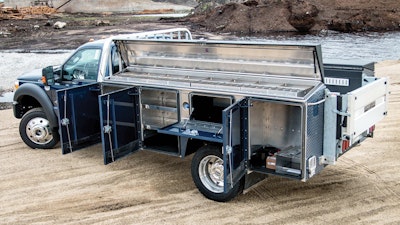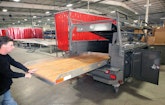
Interested in Trucks?
Get Trucks articles, news and videos right in your inbox! Sign up now.
Trucks + Get AlertsFrom durable surfaces to optimized tool and material storage, service bodies can help bring the shop out into the field. But the market offers a lot of choice, from standard-issue to fully customized. Making sure the service body matches the needs of an installer will help to ensure that it will deliver the best performance at an optimal price.
Highway Products has produced both standard and custom service bodies for more than 30 years in White City, Oregon. All of its service bodies are made of welded aluminum, not only because aluminum is durable and rust-resistant, but because it’s less than half the weight of an identical steel service body. The reduced weight can make a significant dent in contractor fuel cost.
“With a lighter service body you might be able to use an F-150 instead of an F-250 and save some money on the vehicle,” says Highway Products consultant Jim Lenford. “That would more than cover the initial higher price of aluminum over steel.”
Standard utility service bodies are designed for a broad range of industries that could include onsite installers carrying a host of supplies and tools.
Built of 1/8-inch aluminum, Highway Products models bolt into place on existing pickup truck frames. Doors are typically smooth aluminum, while decks, bodies, top boxes and tailgates are diamond plate or other textured finish. These models consist of six storage compartments, fenders, bed, tailgate and a bumper with lighting. Inside the body are four storage compartments with adjustable shelving, two located in front of the wheel well and two behind. Two smaller compartments are located above each fender. The location of a fuel filler bezel depends on the model of the truck.
Contractors can also choose options including toolboxes, headache racks and ladder racks. Highway Products offers a Truckslide option, a steel or aluminum platform that slides out like a drawer along the bottom of the truck bed, allowing material to be off-loaded more easily.
A Pickup Pack model slips into the back of a pickup and turns the bed into lockable storage. The standard model includes two full-length lockable low-side boxes and a flat or domed center hatch. A space underneath the toolboxes provides room for additional cargo.
But no two businesses operate alike, even among installers. Customized service bodies can help improve workflow and provide unique features to accommodate tools and materials.
Making Choices
“Often, our standard service body with options will cover most of our customers’ needs,” says J.D. Martin, sales team leader at Highway Products. “Every now and then we get customers who want cabinets of a certain depth to fit a specific tool, want to build the service body around a particular item, or build something completely off the wall, like a service body built entirely around transporting a drone with camera equipment.”
Customers typically begin by identifying the model of their truck, providing the VIN number to ensure that a design fits the vehicle exactly.
“We ask them if they’ve changed anything on their trucks since buying it,” says Lenford. “Maybe they’ve installed oversized tires or Kelderman Air Ride. A typical truck off the lot measures 56 inches from the back of the cab to the axle, whereas a cab chassis is 60 inches. The 4 inches are critical, as is the fact that the bed won’t have humps in the frame to accommodate the axle.”
Martin next asks customers about their business.
“If you’ve never ordered a custom service body before, you may not know what questions to ask,” he says. “We talk about what they do from day to day. I can suggest options that customers in similar businesses have selected or found beneficial. For example, one of the big options for contractors is topper boxes featuring removable tool trays with handles on them. They can lift them out just like trays in a tool chest and take them to the job site instead of going back and forth.”
For Installers
For installers, Lenford has a series of suggestions.
“Drawers with dividers and compartments are a good option to organize smaller parts and fittings,” he says. “We offer pipe and lumber racks to carry pipe to the job site. We can also add tunnel boxes for pipe, accessible from the back.”
Other options include LED lighting strips that automatically switch on when a compartment is opened. Specialty pole lighting attachments can illuminate a job site at night. Service body baskets can be used to carry hand tools such as shovels, hoes and rakes. Some customers also request a LINE-X spray-on bedliner to ensure that items stored in the bed are less likely to move during transit.
Some requests are discouraged, for example building a service body designed to extend the length of the truck.
“If you have a 6 1/2-foot bed, it’s problematic to order an 8-foot body,” says Lenford. “You can get frame extensions to make it work, but it throws off the center of gravity of the truck. From an aesthetic standpoint, it doesn’t look right either.”
Other customers have requested service bodies with canopies that are too tall for the truck, something the company discourages because it subjects the vehicle to destabilizing winds. Service bodies wider than the truck bed also catch wind and affect handling.
Mostly DIY
Although they can drive their trucks to the shop to have the service body bolted on, customers most often have the service body shipped, along with a mounting kit containing from 16 to 24 bolts.
“If you were thinking of installing it yourself, you’d want enough people or a forklift to lift it into position,” says Martin. “After that, it’s easy to bolt on.”







